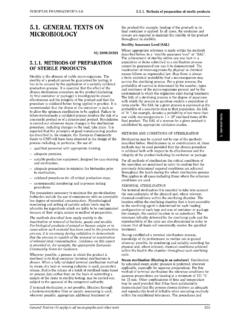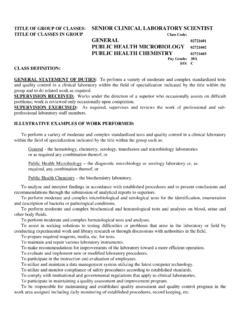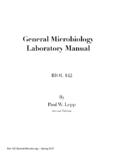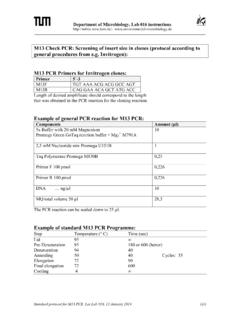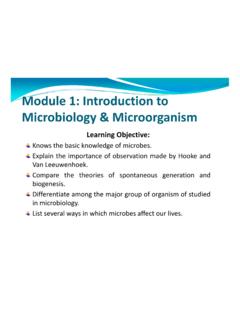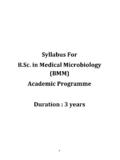Transcription of Cost Effective Clinical Microbiology
1 California Association for Medical Laboratory Technology Distance Learning Program cost Effective Clinical Microbiology by James I. Mangels, MA, CLS, MT (ASCP), F(AAM) Microbiology Consulting Services Santa Rosa, CA Course Number: DL-984 CE/Contact Hour Level of Difficulty: Intermediate California Association for Medical Laboratory Technology. Permission to reprint any part of these materials, other than for credit from CAMLT, must be obtained in writing from the CAMLT Executive Office. CAMLT is approved by the California Department of Health Services as a CA CLS Accrediting Agency (#0021) and this course is is approved by ASCLS for the Program (#519) 1895 Mowry Ave, Suite 112 Fremont, CA 94538-1766 Phone: 510-792-4441 FAX: 510-792-3045 Notification of Distance Learning Deadline All continuing education units required to renew your license must be earned no later than the expiration date printed on your license.
2 If some of your units are made up of Distance Learning courses, please allow yourself enough time to retake the test in the event you do not pass on the first attempt. CAMLT urges you to earn your CE units early!. 1 CAMLT Distance Learning Course DL-984 CAMLT 2008 cost Effective Clinical Microbiology Outline I. Introduction II. History III. Where cost savings can be implemented IV. Factors related to patient testing V. Factors related to laboratory technical operations VI. Factors related to laboratory management operations VII. Conclusions VIII. References IX. Tables X. Questions After completing this course the participant will be able to: 1. Discuss the role of laboratory expenditures in the cost of health care. 2. Outline the history of cost -based reimbursement during the fee-for-service era.
3 3. Explain how the laboratory can control cost . 4. Outline methods to control cost in the Microbiology laboratory. 5. Explain laboratory technical operation methods to control cost . 6. State obstacles and methods to deal with test ordering practices. 7. Identify the laboratory management operations methods to help control cost . I. INTRODUCTION It has been well known for some time that the United States spends more per capita on health care than other countries. What may be less well known is that the United States has had one of the highest increases in per capita health care spending since 1980 among higher income countries (1). Health care spending around the world generally is rising at a faster rate than overall economic growth, so almost all countries have seen health care spending increase as a percentage of their gross domestic product (GDP).
4 In the United States, which has had both a high level of health spending per capita and a relatively high rate of real growth, the share of GDP devoted to health grew from of GDP in 1980 to 16 % of GDP today (1). This increase in the health share of GDP is larger than increases seen in other high-income countries. Total spending for health care was $ trillion in 2006, or $7,110 per person. The Centers for Medicare and Medicaid Services (CMS) has projected health care expenditures to reach $4 trillion in 2015, or 20 percent of GDP. Per person health spending is projected to increase to $12,320 by the end of that period (1). There are a variety of reasons for the current state of high health care costs in the United States (2, 3). Whether one attributes the high costs to waste and inefficiency, inflated prices, poor management, inappropriate care, or over-consumption, the cost is too high.
5 Many economists and health policy analysts argue that new medical technology (new drugs, devices, treatments, and techniques) is responsible for a substantial portion of the growth in health expenditures. The cost of health care has exceeded what the public is willing to pay, especially in view of the growing realization or perception that increased expenditures have only marginally improved the health in our country. See Table 1, Health Care Facts. This distance learning course addresses one specific aspect of health care spending: Clinical Microbiology laboratory tests and the costs associated with them. This course explains how Clinical Microbiology laboratory costs affect patients, institutions, and the health care system, and offers suggestions for how we in the Clinical Microbiology laboratory can reduce our costs.
6 2 CAMLT Distance Learning Course DL-984 CAMLT 2008 II. HISTORY Years ago, rapidly increasing medical costs were not of concern to the health care industry. Most medical care providers worked in an environment of cost -based reimbursement fee for service, a system that offered few incentives for cost -effectiveness and certainly caused over- utilization of diagnostic services. Those were the good old days for Clinical laboratories. The more tests you did and the more you charged per test, the more revenue you received. Under fee for service, three separate urine cultures or multiple wound or sputum cultures on the same patient in one day, for example, were acceptable. All specimens were accepted regardless of the number and/or quality or the impact to patient care, and the laboratory received payment for all testing performed (2).
7 The hospital administration looked favorably upon laboratory operations during this time because the laboratory was considered a revenue generating center. Often, the laboratory financially supported other non-revenue-generating areas of the hospital, such as dietary and housekeeping. Also, funds generated from multiple testing were used to help subsidize the cost of more expensive lab tests, such as tuberculosis (TB) or fungal cultures, and other lab services in which supply and labor costs were high. However, times have changed. Now as the health care system moves to prospective reimbursement (payment according to contracted pricing), medical providers must address new issues: the best use of the laboratory s resources, how to assure quality test results, and which tests to order for optimal patient care, yet at reasonable cost .
8 Today, the more laboratory tests you perform, the more revenue you lose because contracted pricing does not cover the true cost of performing each laboratory test. The laboratory is now considered a cost center and competes for funds with all other cost centers in the hospital. The Clinical Microbiology laboratory is no longer looked upon so favorably. Whereas its previous role was as a generator of revenue, the Clinical Microbiology laboratory is now just another consumer of resources, and consequently is one of the major targets for reduction of costs. Microbiology is an expensive laboratory service because it is labor intensive. Staff salaries generally account for 60 to 70% of the Microbiology laboratory s operating budget. Most Microbiology tests cannot be automated easily, so there is a direct relationship between work load and number of Clinical Laboratory Scientists (CLS) needed.
9 Although many factors contribute to escalating health care costs, an increase in the utilization of health services, especially diagnostic services, is considered to be one of the most important elements. Laboratory and X-ray charges currently account for 30-40% of all hospital costs and are the most rapidly increasing component of the nation s health bill. Laboratory charges are increasing annually at a rate of about 15% and are considered an important contributor to the general inflation in medical cost (1). It has been estimated that in some acute tertiary-care hospitals, Clinical laboratory test charges alone average 24% of the total hospital bill of patients (2). The magnitude of these cost increases has caused federal agencies considerable concern, prompting them to initiate policies such as the establishment of CLIA 88 legislation to regulate Clinical laboratories and control unnecessary costs associated with laboratory testing.
10 This legislation was intended to restructure laboratories through personnel requirements, testing services, and reimbursement practices to force health service organizations to implement more cost - Effective techniques. Two factors in particular contribute to the rising cost of laboratory services: increased test cost and increased utilization (test ordering). It has been determined that one half of the laboratory cost increase is the result of increased costs to perform the test, and half is due to increased utilization and new services, not due to inflation. Further, authorities believe that 20- 60% of laboratory tests may be unnecessary and inappropriate, and do not contribute to improved patient care (3). Therefore, changing test ordering practices without compromising the quality of patient care is an important aspect of cost -effectiveness in Clinical laboratories.



